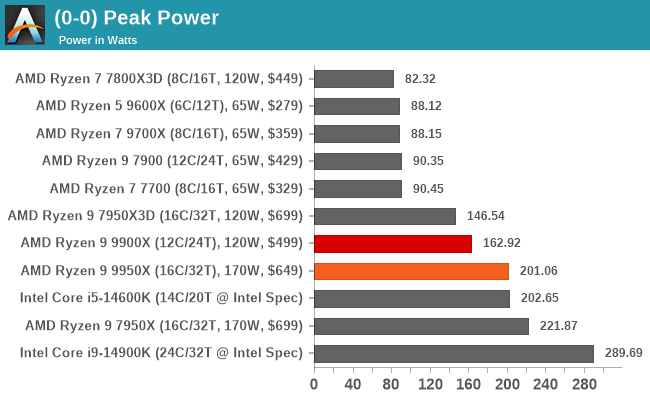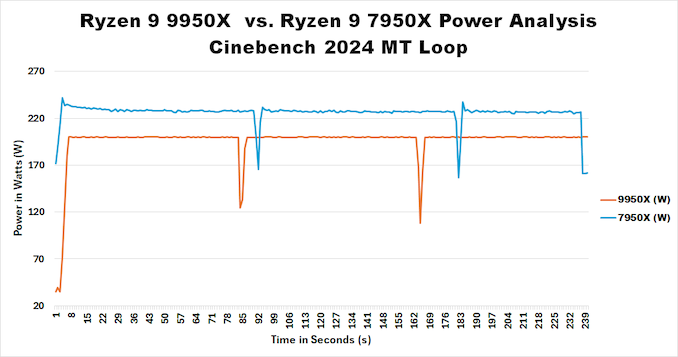The AMD Ryzen 9 9950X and Ryzen 9 9900X Review: Flagship Zen 5 Soars - and Stalls
by Gavin Bonshor on August 14, 2024 9:00 AM EST- Posted in
- CPUs
- AMD
- Desktop
- Zen 5
- AM5
- Ryzen 9000
- Ryzen 9 9950X
- Ryzen 9 9900X
Power Consumption
Our previous sets of ‘office’ benchmarks have often been a mix of science and synthetics, so this time, we wanted to keep our office and productivity section purely based on real-world performance. We've also incorporated our power testing into this section.
The biggest update to our Office-focused tests for 2024 and beyond includes UL's Procyon software, the successor to PCMark. Procyon benchmarks office performance using Microsoft Office applications, with other web-based benchmarks such as Jetstream and timed runs of compilers, including Linux, PHP, and Node.js.
Below are the settings we have used for each platform:
- DDR5-5600B CL46 - Ryzen 9000
- DDR5-5600B CL46 - Intel 14th & 13th Gen
- DDR5-5200 CL44 - Ryzen 7000
Power
The nature of reporting processor power consumption has become, in part, a bit of a nightmare. Historically the peak power consumption of a processor, as purchased, is given by its Thermal Design Power (TDP, or PL1). For many markets, such as embedded processors, that value of TDP still signifies the peak power consumption. For the processors we test at AnandTech, either desktop, notebook, or enterprise, this is not always the case.
Modern high-performance processors implement a feature called Turbo. This allows, usually for a limited time, a processor to go beyond its rated frequency. Exactly how far the processor goes depends on a few factors, such as the Turbo Power Limit (PL2), whether the peak frequency is hard coded, the thermals, and the power delivery. Turbo can sometimes be very aggressive for TDP that are, broadly speaking, applied the same. The difference comes from turbo modes, turbo limits, turbo budgets, and how the processors manage that power balance. These topics are 10000-12000 word articles in their own right, and we’ve got a few articles worth reading on the topic.
- Why Intel Processors Draw More Power Than Expected: TDP and Turbo Explained
- Talking TDP, Turbo and Overclocking: An Interview with Intel Fellow Guy Therien
- Reaching for Turbo: Aligning Perception with AMD’s Frequency Metrics
- Intel’s TDP Shenanigans Hurts Everyone

Looking at the peak power of both the Ryzen 9 9950X and the Ryzen 9 9900X, we can see that they both overshoot their TDP because AMD has another power target called Package Power Tracking (PPT). Interestingly, the Ryzen 9 9950X pulls less power at peak than the Intel Core i5-14600K, even when the Intel chip is set to Intel's recommended specification. Both the Ryzen 9 chips stack up exactly where we would expect to see them, with around 30 W more at peak due to PPT on the 9950X, and it still pulls less power at peak than the Ryzen 9 7950X that it replaces.
Looking at the difference in power between the Ryzen 9 9950X and the previous Ryzen 9 7950X it replaces, we can clearly see that the Zen 5 16C/32T chip is more efficient power efficient at full load. The Ryzen 9 9950X within the Cinebench 2024 multi-threaded benchmark is consistently pulling around 200 W, which, although 30 W higher than its rated TDP, is still well within the 30% uptick that PPT allows it to hit. Despite both Ryzen 9 chips having the same 170 W TDP., AMD's Package Power Tracking and the 7950X pull more power at full load and for less performance overall, as can be highlighted in the rendering results section of our testing.











123 Comments
View All Comments
Khanan - Wednesday, August 14, 2024 - link
“AMD has doubled the amount of L2 cache per core on Zen 5 to 1 MB, which is up from 512KB per Zen 4 core.”This isn’t right. L2 cache was already doubled from Zen 3 to Zen 4 to 1 MB, you already did this mistake a few times now.
Ryan Smith - Wednesday, August 14, 2024 - link
You are correct! That has been fixed. Thank you.eva02langley - Wednesday, August 14, 2024 - link
I saw Steve and Steve still going strong with their nonsense. They were complaining again so I came here to have a REAL CPU review.Good old Anandtech is still setting the bar for what I should expect in a CPU review.
Khanan - Wednesday, August 14, 2024 - link
I mean the chief reason for these architectures, as AMD uses Zen 5 chiplets also in the server, is the server or data center not desktops - that’s where the big money is. And after that laptops. So AMD doesn’t worry too much about those gaming YouTubers that hype everything as YouTubers always do despite it not making too much sense or having low relevance. What those want is the X3D processors anyway, those are for the gamers specifically, these aren’t as much, these are general architectures reused for the desktop (just not 1:1 in the laptop anymore).eva02langley - Wednesday, August 14, 2024 - link
You don't teach me anything, I know that already.My point is that they are complaining because they are focusing on games while a CPU IPC is NOT limited to gaming, on the contrary, it is a really small portion of it.
Phoronix came out with a 17.5% geomean over the 7950x, well inline or even better than AMD's 16% IPC uplift.
thestryker - Wednesday, August 14, 2024 - link
Keep in mind the only reason Phoronix saw that much uplift is the AVX512 change not because they're actually that much improved. They mentioned at the end of the review that they'll be doing further testing without AVX512 for comparisons.Oxford Guy - Friday, August 16, 2024 - link
Greatly improved AVX-512 is more of an improvement than we've seen from some CPU releases.coburn_c - Wednesday, August 14, 2024 - link
Not true at all, GN repeatedly said don't buy these chips for gaming. YOU are complaining without focusing, and you look like a clown.Gothmoth - Saturday, August 24, 2024 - link
indeed he looks like a very dumb clown.....Lonyo - Thursday, August 15, 2024 - link
GAMERS Nexus is focusing on GAME performance?